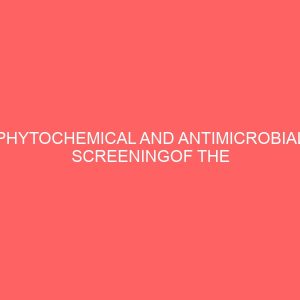Description
CHAPTER ONE
1.0 INTRODUCTION
1.1 Definition of a drug
A drug can be described as any chemical substance that has no nutritional value when
introduced into the body but causes some physiological effects within the system (Mbah, 2000). Drugs are classified under pharmaceuticals. Pharmaceutical drug, according to Dey (2006), also refers to as medicine or medicament, can be loosely defined as any substance intended for use in the diagnosis, cure, mitigation, treatment or prevention of diseases.
Some pharmaceuticals occur naturally in plants. These can be called phyto pharmaceuticals. By the strictest definition, they are drugs or chemicals that may have health related effects but are not considered essential nutrients. Protein, carbohydrates, fats, minerals and vitamins are regarded as essential nutrients. Some pharmaceuticals found in plants include gedunin and nimbolide from Azadirachta indica (Neem) (Khalid and Duddeck, 1993); santonin, a sesquiterpenoid lactone is found in species of Artemisia which grows in Asia, quinine and alkaloid occurs in the bark of cinchona tree; penincillin- a beta-lactam is produced by fungi in the genus Penicillium (Finar, 2003) and reserpine-an alkaloid is isolated from Rauwolfia plant.
1.2Medicinal plants
According to biblical records, Prophet Ezekiel reported that the fruits will serve as food and their leaves for healing (Ezekiel 47:12). Thus, the use of plants for medicinal purposes dates back to thousands of years ago as the earliest humans used various plants to treat illness
1
(Dey, 2006). Medicinal plants or healing herbs, as they are called, are used in treating and preventing specific ailments and diseases and as such are considered to play a beneficial role in health care.
Srivastava et al., (1996) earlier stated that hundreds of plant species are recognized as having medicinal values and four out of every five of those plants are collected from the wild forest while most are from the flora of developing countries. The medicinal properties or values may be present in one or all the plants parts like roots, stem, back, leaves, flower, fruit or seeds.
In fact, with all the progress in synthetic chemistry and biotechnology, plants are still indispensable source of drugs and natural products on the basis of their therapeutics (Lawn, 1993).
Some common medicinal plants that occur in our locality includeAzadirachta indica
(Neem), Ocimum gratissiumpersea americana, Vernonica amygdaline, Astonia boonei,
Zanthoxyllium gilleti and Bucchslozia coreacae among others.
1.3 Medicinal plant research
The efficacy of these medicinal plants is based on the presence of secondary metabolites which belong to a group of compounds called natural products. Natural products are those chemical compounds derived from living organisms, plants, animals, insects and the study of natural products is the investigation of their structure formation, applications and purpose in the organisms. The drugs or active ingredients derived from natural products are usually secondary metabolites, for example, terpenes, flavonoids, saponins and alkaloids and their derivatives. Today, these compounds must be pure and highly characterized compounds through scientific research.
2
Medicinal plant research starts by people carrying out general screening of plants which are collected either randomly or based on local reputations as medicinal plants after botanically identified by a reputable authority or plant taxonomist. This screening consists mainly of solvent extraction and standard tests of the extracts for the presence of such class of compounds or secondary metabolites as alkaloids, saponins and phenolic compounds. This in itself may not lead to the discovery of any new biologically active compound if carried out competently and consistently but it could provide data from which plants with potential biological activity could be selected for further detailed study (Adjanohoun et al., 1991,Farnsworth,1996).
The extracts are then fractionated with a view of isolating pure compounds. Modern isolation techniques include all types of chromatography often guided by bioassays to isolate the active compounds. The chromatographic procedures include absorption and partition chromatography in columns, thin layer and recently high performance liquid Chromatography. The structures of the isolatein modern times are elucidated primarily by spectroscopic techniques. The compounds can be identified as already known compounds or entirely new compounds.
1.3.1 AIM
1. The aim of this work was to justify or otherwise the claimed ethnomedicinal uses of the plant
1.3.2 OBJECTIVES
I. Collection, proper botanical identification, drying and pulverizing of the plant.
3
II. Extraction of the powdered plant material using different solvents based on the elutropic series i.e from non-polar to most polar.
III.The extract of this plant would be subjected to phytochemical and antimicrobial
screening
IV. Analytical separations involving several consecutive steps of chromatographic
techniques.
V. Structural elucidation of the isolated compound(s) using spectral techniques
1.4:SCOPE AND LIMITATION OF THE RESEARCH
The scope of this research work would be:
1. The phytochemical screening, antibacterial, antifungal screening, isolation, characterization and structural elucidation of the active principles of Indigofera arrecta.
1.5 JUSTIFICATION OF THE RESEARCH
The need to know the active ingredients in the stem of Indigofera arrecta which are responsible for the cure/treatment of various ailments such as epilepsy, sores treatment, diarrhea and ulcer and to have scientific evidence of the claims of the ethnomedicinal practices of the stem of Indigofera arrecta.







